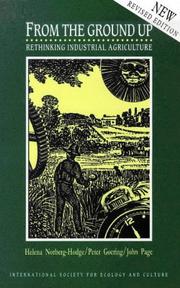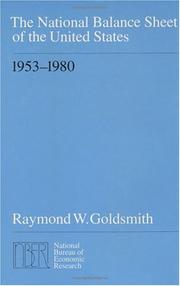| Listing 1 - 4 of 4 |
Sort by
|

ISBN: 1856499936 1856499944 Year: 2001 Publisher: London Zed Books
Abstract | Keywords | Export | Availability | Bookmark
 Loading...
Loading...Choose an application
- Reference Manager
- EndNote
- RefWorks (Direct export to RefWorks)
Agricultural ecology --- Agricultural innovations --- Agriculture --- Sustainable agriculture --- 631.145 --- 631.145 Factory and farm enterprises combined. Industrialized farming generally --- Factory and farm enterprises combined. Industrialized farming generally --- Low-input agriculture --- Low-input sustainable agriculture --- Lower input agriculture --- Resource-efficient agriculture --- Sustainable farming --- Alternative agriculture --- Agrarian question --- Agribusiness --- Agricultural economics --- Agricultural production economics --- Production economics, Agricultural --- Land use, Rural --- Farming --- Husbandry --- Industrial arts --- Life sciences --- Food supply --- Innovations, Agricultural --- Technological change in agriculture --- Technological innovations --- Agroecology --- Ecology --- Permaculture --- Economic aspects --- Innovations --- Technology transfer --- Environmental aspects --- Agriculture. Animal husbandry. Hunting. Fishery

ISBN: 0226301524 1336022639 0226301575 9780226301570 9780226301525 Year: 1982 Publisher: Chicago University of Chicago Press
Abstract | Keywords | Export | Availability | Bookmark
 Loading...
Loading...Choose an application
- Reference Manager
- EndNote
- RefWorks (Direct export to RefWorks)
In what constitutes a landmark in the field of national accounts, Raymond W. Goldsmith gives detailed estimates of the nation's assets and liabilities year by year from 1953 through 1975 and for the benchmark years of 1900, 1929, and 1980. Special features of this work include presentation of data sector by sector, which casts light on the changing roles of financial institutions, and Goldsmith's expression of data in the form of ratios rather than in absolute dollar values, a device that makes the material both more informative and easier to absorb. The most comprehensive and extensive study of national wealth ever attempted, The National Balance Sheet will be a rich resource for researchers and users of national accounts.
National accounts --- United States --- National income --- Accounting. --- Accounting --- E-books --- 307.366 --- 339.110 --- 339.111 --- 339.112.0 --- US / United States of America - USA - Verenigde Staten - Etats Unis --- Statistieken van het openbaar en particulier vermogen --- Nationaal vermogen: algemeenheden --- Openbaar vermogen. Onteigeningen. Provinciaal en gemeentelijk domein --- Particulier vermogen: algemeenheden --- National income - United States - Accounting. --- macroeconomics, united states history, economy, economics, debt, national accounts, assets, liabilities, financial institutions, finance, banks, banking, accounting, absolute dollar values, extensive study, wealth, money, power, income, deficit spending, balance sheet, valuations, deflation, regional differences, farming, farm enterprises, big business, taxation, capital, capitalism, female wealthholders. --- United States of America
Book
Year: 2009 Publisher: Washington, D.C., The World Bank,
Abstract | Keywords | Export | Availability | Bookmark
 Loading...
Loading...Choose an application
- Reference Manager
- EndNote
- RefWorks (Direct export to RefWorks)
This paper compares and contrasts the performance of rural and urban manufacturing firms in Ethiopia to assess the impact of market integration and the investment climate on firm performance. Rural firms are shown to operate in isolated markets, have poor access to infrastructure and a substantial degree of market power, whereas urban firms operate in better integrated and more competitive markets, where they have much better access to inputs. Fragmentation may also help explain why urban firms are much larger, much more capital intensive and why they produce much more output per worker. Capital intensity and labor productivity are strongly correlated with firm size. Manufacturing technology choice does not vary strongly across space and increasing returns to scale are modest at best, suggesting that rural-urban differences in output per worker are predominantly driven by differences in capital intensity and Total Factor Productivity (TFP). The average TFP of firms in rural towns is much higher than that of rural firms in remote areas, but small firms in rural towns are not significantly less productive than small firms in other urban areas. A key finding of the paper is that market fragmentation and investment climate constraints impair the growth of the rural non-farm sector. Whereas urban firms exhibit a healthy dynamism, rural firms are stagnant and lack incentives to invest. Paradoxically, limited local demand due to market fragmentation is the most pressing constraint for rural firms, even though they face more severe supply-side constraints than urban firms. Promoting market towns in Ethiopia might be an effective means of capitalizing on the gains from market integration.
Access to Finance --- Access to finance --- Banks and Banking Reform --- Commercial finance --- Debt Markets --- Diversification --- E-Business --- Economic activity --- Economic development --- Economic Theory and Research --- Economies of scale --- Employment opportunities --- Enterprise growth --- Farm enterprise --- Farm enterprises --- Finance and Financial Sector Development --- Financial services --- Financial support --- Foreign investment --- Group of firms --- Infrastructure Economics and Finance --- International bank --- Investment and Investment Climate --- Labor and Social Protections --- Labor Policies --- Macroeconomics and Economic Growth --- Microfinance --- Overdraft --- Poor access --- Private Participation in Infrastructure --- Private Sector Development --- Rural Development --- Rural Poverty Reduction --- Small enterprises --- Transaction costs --- Urban areas
Book
Year: 2009 Publisher: Washington, D.C., The World Bank,
Abstract | Keywords | Export | Availability | Bookmark
 Loading...
Loading...Choose an application
- Reference Manager
- EndNote
- RefWorks (Direct export to RefWorks)
This paper compares and contrasts the performance of rural and urban manufacturing firms in Ethiopia to assess the impact of market integration and the investment climate on firm performance. Rural firms are shown to operate in isolated markets, have poor access to infrastructure and a substantial degree of market power, whereas urban firms operate in better integrated and more competitive markets, where they have much better access to inputs. Fragmentation may also help explain why urban firms are much larger, much more capital intensive and why they produce much more output per worker. Capital intensity and labor productivity are strongly correlated with firm size. Manufacturing technology choice does not vary strongly across space and increasing returns to scale are modest at best, suggesting that rural-urban differences in output per worker are predominantly driven by differences in capital intensity and Total Factor Productivity (TFP). The average TFP of firms in rural towns is much higher than that of rural firms in remote areas, but small firms in rural towns are not significantly less productive than small firms in other urban areas. A key finding of the paper is that market fragmentation and investment climate constraints impair the growth of the rural non-farm sector. Whereas urban firms exhibit a healthy dynamism, rural firms are stagnant and lack incentives to invest. Paradoxically, limited local demand due to market fragmentation is the most pressing constraint for rural firms, even though they face more severe supply-side constraints than urban firms. Promoting market towns in Ethiopia might be an effective means of capitalizing on the gains from market integration.
Access to Finance --- Access to finance --- Banks and Banking Reform --- Commercial finance --- Debt Markets --- Diversification --- E-Business --- Economic activity --- Economic development --- Economic Theory and Research --- Economies of scale --- Employment opportunities --- Enterprise growth --- Farm enterprise --- Farm enterprises --- Finance and Financial Sector Development --- Financial services --- Financial support --- Foreign investment --- Group of firms --- Infrastructure Economics and Finance --- International bank --- Investment and Investment Climate --- Labor and Social Protections --- Labor Policies --- Macroeconomics and Economic Growth --- Microfinance --- Overdraft --- Poor access --- Private Participation in Infrastructure --- Private Sector Development --- Rural Development --- Rural Poverty Reduction --- Small enterprises --- Transaction costs --- Urban areas
| Listing 1 - 4 of 4 |
Sort by
|

 Search
Search Feedback
Feedback About UniCat
About UniCat  Help
Help News
News